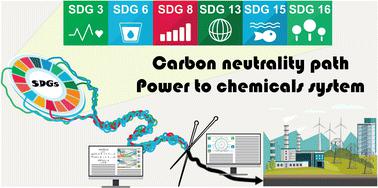当前位置:
X-MOL 学术
›
Energy Environ. Sci.
›
论文详情
Our official English website, www.x-mol.net, welcomes your
feedback! (Note: you will need to create a separate account there.)
Trade-offs between Sustainable Development Goals in carbon capture and utilisation
Energy & Environmental Science ( IF 32.4 ) Pub Date : 2022-08-31 , DOI: 10.1039/d2ee01153k Iasonas Ioannou 1 , Ángel Galán-Martín 2, 3 , Javier Pérez-Ramírez 1 , Gonzalo Guillén-Gosálbez 1
Energy & Environmental Science ( IF 32.4 ) Pub Date : 2022-08-31 , DOI: 10.1039/d2ee01153k Iasonas Ioannou 1 , Ángel Galán-Martín 2, 3 , Javier Pérez-Ramírez 1 , Gonzalo Guillén-Gosálbez 1
Affiliation

|
Carbon capture and utilisation (CCU) provides an appealing framework to turn carbon emissions into valuable fuels and chemicals. However, given the vast energy required to activate the CO2 molecule, CCU may have implications on sustainable development that are still poorly understood due to the narrow scope of current carbon footprint-oriented assessments lacking absolute sustainability thresholds. To bridge this gap, we developed a power-chemicals nexus model to look into the future and understand how we could produce 22 net-zero bulk chemicals of crucial importance in a sustainable manner by integrating fossil, CCU routes and power technologies, often assessed separately. We evaluated the environmental performance of these technologies in terms of their contribution to 5 Sustainable Development Goals (SDGs), using 16 life cycle assessment metrics and 9 planetary boundaries (PB) to quantify and interpret the impact values. We found that fossil chemicals could hamper the attainment of SDG 3 on good health and well-being and SDG 13 on climate change. CCU could help meet SDG 13 but would damage other SDGs due to burden-shifting to human health, water scarcity, and minerals and metals depletion impacts. The collateral damage could be mitigated by judiciously combining fossil and CCU routes with carbon-negative power sources guided by optimisation models incorporating SDGs-based performance criteria explicitly. Our work highlights the importance of embracing the SDGs in technology development to sensibly support the low-carbon energy and chemicals transition.
中文翻译:

碳捕获和利用的可持续发展目标之间的权衡
碳捕获和利用 (CCU) 提供了一个有吸引力的框架,可以将碳排放转化为有价值的燃料和化学品。然而,考虑到激活 CO 2所需的巨大能量分子,CCU 可能对可持续发展产生影响,但由于当前以碳足迹为导向的评估范围狭窄,缺乏绝对可持续性阈值,因此人们仍知之甚少。为了弥合这一差距,我们开发了一个电力-化学品关系模型,以展望未来并了解我们如何通过整合化石、CCU 路线和电力技术(通常单独评估)以可持续的方式生产 22 种至关重要的净零散装化学品. 我们根据这些技术对 5 个可持续发展目标 (SDG) 的贡献评估了这些技术的环境绩效,使用 16 个生命周期评估指标和 9 个行星边界 (PB) 来量化和解释影响值。我们发现,化石化学品可能会阻碍实现关于良好健康和福祉的可持续发展目标 3 以及关于气候变化的可持续发展目标 13。CCU 可以帮助实现 SDG 13,但由于负担转移到人类健康、水资源短缺以及矿物和金属枯竭的影响,会损害其他 SDG。通过在优化模型的指导下明确结合基于 SDG 的性能标准,明智地将化石和 CCU 路线与负碳能源相结合,可以减轻附带损害。我们的工作强调了在技术开发中接受可持续发展目标以明智地支持低碳能源和化学品转型的重要性。通过在优化模型的指导下明确结合基于 SDG 的性能标准,明智地将化石和 CCU 路线与负碳能源相结合,可以减轻附带损害。我们的工作强调了在技术开发中接受可持续发展目标以明智地支持低碳能源和化学品转型的重要性。通过在优化模型的指导下明确结合基于 SDG 的性能标准,明智地将化石和 CCU 路线与负碳能源相结合,可以减轻附带损害。我们的工作强调了在技术开发中接受可持续发展目标以明智地支持低碳能源和化学品转型的重要性。
更新日期:2022-08-31
中文翻译:

碳捕获和利用的可持续发展目标之间的权衡
碳捕获和利用 (CCU) 提供了一个有吸引力的框架,可以将碳排放转化为有价值的燃料和化学品。然而,考虑到激活 CO 2所需的巨大能量分子,CCU 可能对可持续发展产生影响,但由于当前以碳足迹为导向的评估范围狭窄,缺乏绝对可持续性阈值,因此人们仍知之甚少。为了弥合这一差距,我们开发了一个电力-化学品关系模型,以展望未来并了解我们如何通过整合化石、CCU 路线和电力技术(通常单独评估)以可持续的方式生产 22 种至关重要的净零散装化学品. 我们根据这些技术对 5 个可持续发展目标 (SDG) 的贡献评估了这些技术的环境绩效,使用 16 个生命周期评估指标和 9 个行星边界 (PB) 来量化和解释影响值。我们发现,化石化学品可能会阻碍实现关于良好健康和福祉的可持续发展目标 3 以及关于气候变化的可持续发展目标 13。CCU 可以帮助实现 SDG 13,但由于负担转移到人类健康、水资源短缺以及矿物和金属枯竭的影响,会损害其他 SDG。通过在优化模型的指导下明确结合基于 SDG 的性能标准,明智地将化石和 CCU 路线与负碳能源相结合,可以减轻附带损害。我们的工作强调了在技术开发中接受可持续发展目标以明智地支持低碳能源和化学品转型的重要性。通过在优化模型的指导下明确结合基于 SDG 的性能标准,明智地将化石和 CCU 路线与负碳能源相结合,可以减轻附带损害。我们的工作强调了在技术开发中接受可持续发展目标以明智地支持低碳能源和化学品转型的重要性。通过在优化模型的指导下明确结合基于 SDG 的性能标准,明智地将化石和 CCU 路线与负碳能源相结合,可以减轻附带损害。我们的工作强调了在技术开发中接受可持续发展目标以明智地支持低碳能源和化学品转型的重要性。











































 京公网安备 11010802027423号
京公网安备 11010802027423号